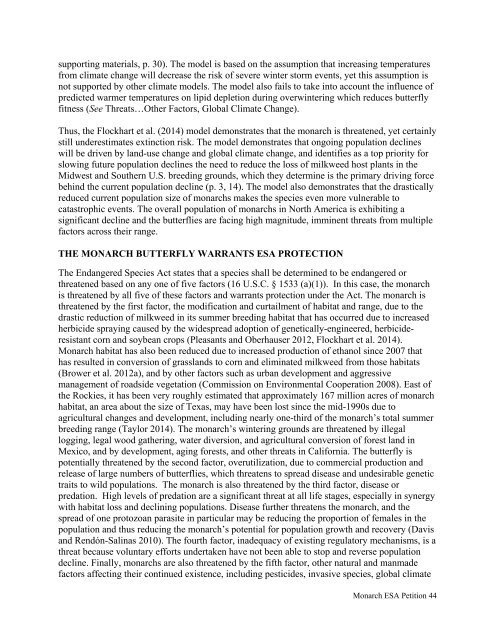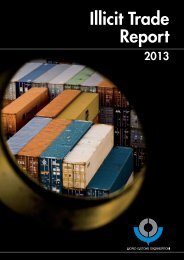monarch-esa-petition-final_61585
monarch-esa-petition-final_61585
monarch-esa-petition-final_61585
Create successful ePaper yourself
Turn your PDF publications into a flip-book with our unique Google optimized e-Paper software.
supporting materials, p. 30). The model is based on the assumption that increasing temperatures<br />
from climate change will decrease the risk of severe winter storm events, yet this assumption is<br />
not supported by other climate models. The model also fails to take into account the influence of<br />
predicted warmer temperatures on lipid depletion during overwintering which reduces butterfly<br />
fitness (See Threats…Other Factors, Global Climate Change).<br />
Thus, the Flockhart et al. (2014) model demonstrates that the <strong>monarch</strong> is threatened, yet certainly<br />
still underestimates extinction risk. The model demonstrates that ongoing population declines<br />
will be driven by land-use change and global climate change, and identifies as a top priority for<br />
slowing future population declines the need to reduce the loss of milkweed host plants in the<br />
Midwest and Southern U.S. breeding grounds, which they determine is the primary driving force<br />
behind the current population decline (p. 3, 14). The model also demonstrates that the drastically<br />
reduced current population size of <strong>monarch</strong>s makes the species even more vulnerable to<br />
catastrophic events. The overall population of <strong>monarch</strong>s in North America is exhibiting a<br />
significant decline and the butterflies are facing high magnitude, imminent threats from multiple<br />
factors across their range.<br />
THE MONARCH BUTTERFLY WARRANTS ESA PROTECTION<br />
The Endangered Species Act states that a species shall be determined to be endangered or<br />
threatened based on any one of five factors (16 U.S.C. § 1533 (a)(1)). In this case, the <strong>monarch</strong><br />
is threatened by all five of these factors and warrants protection under the Act. The <strong>monarch</strong> is<br />
threatened by the first factor, the modification and curtailment of habitat and range, due to the<br />
drastic reduction of milkweed in its summer breeding habitat that has occurred due to increased<br />
herbicide spraying caused by the widespread adoption of genetically-engineered, herbicideresistant<br />
corn and soybean crops (Pleasants and Oberhauser 2012, Flockhart et al. 2014).<br />
Monarch habitat has also been reduced due to increased production of ethanol since 2007 that<br />
has resulted in conversion of grasslands to corn and eliminated milkweed from those habitats<br />
(Brower et al. 2012a), and by other factors such as urban development and aggressive<br />
management of roadside vegetation (Commission on Environmental Cooperation 2008). East of<br />
the Rockies, it has been very roughly estimated that approximately 167 million acres of <strong>monarch</strong><br />
habitat, an area about the size of Texas, may have been lost since the mid-1990s due to<br />
agricultural changes and development, including nearly one-third of the <strong>monarch</strong>’s total summer<br />
breeding range (Taylor 2014). The <strong>monarch</strong>’s wintering grounds are threatened by illegal<br />
logging, legal wood gathering, water diversion, and agricultural conversion of forest land in<br />
Mexico, and by development, aging forests, and other threats in California. The butterfly is<br />
potentially threatened by the second factor, overutilization, due to commercial production and<br />
release of large numbers of butterflies, which threatens to spread disease and undesirable genetic<br />
traits to wild populations. The <strong>monarch</strong> is also threatened by the third factor, disease or<br />
predation. High levels of predation are a significant threat at all life stages, especially in synergy<br />
with habitat loss and declining populations. Disease further threatens the <strong>monarch</strong>, and the<br />
spread of one protozoan parasite in particular may be reducing the proportion of females in the<br />
population and thus reducing the <strong>monarch</strong>’s potential for population growth and recovery (Davis<br />
and Rendón-Salinas 2010). The fourth factor, inadequacy of existing regulatory mechanisms, is a<br />
threat because voluntary efforts undertaken have not been able to stop and reverse population<br />
decline. Finally, <strong>monarch</strong>s are also threatened by the fifth factor, other natural and manmade<br />
factors affecting their continued existence, including pesticides, invasive species, global climate<br />
Monarch ESA Petition 44




